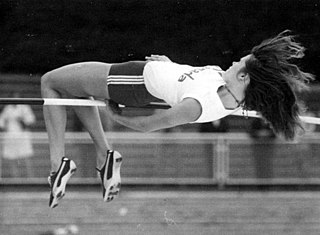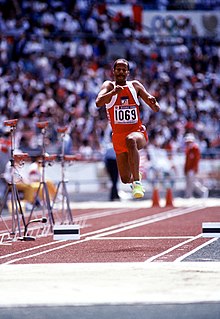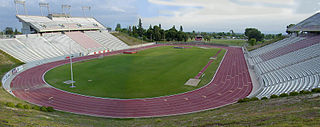
James Ronald Ryun is a former American politician and track and field athlete, who at his peak was widely considered the world's top middle-distance runner. He won a silver medal in the 1500 m at the 1968 Summer Olympics, and was the first high school athlete to run a mile in under four minutes. He is the last American to hold the world record in the mile run. Ryun later served in the United States House of Representatives from 1996 to 2007, representing Kansas' 2nd congressional district for the Republican Party.

Richard Douglas Fosbury is an American retired high jumper, who is considered one of the most influential athletes in the history of track and field. Besides winning a gold medal at the 1968 Olympics, he revolutionized the high jump event with a "back-first" technique, now known as the Fosbury Flop, adopted by almost all high jumpers today. His method was to sprint diagonally towards the bar, then curve and leap backwards over the bar, which gave him a much lower center of mass in flight than traditional techniques. He continues to be involved in athletics and serves on the executive board of the World Olympians Association.

Serhiy Nazarovych Bubka is a Ukrainian former pole vaulter. He represented the Soviet Union until its dissolution in 1991. Bubka was twice named Athlete of the Year by Track & Field News, and in 2012 was one of 24 athletes inducted as inaugural members of the International Association of Athletics Federations Hall of Fame.

Harold Marion Osborn D.O. was a U.S. track athlete. He won a gold medal in Olympic decathlon and high jump in 1924. The apex of the athletic career of Harold M. Osborn occurred at the 1924 Olympic games in Paris, France. Osborn was the first and, to this day, the only athlete ever to win gold in both the decathlon and an individual event.
Calvin Smith is a former sprint track and field athlete from the United States. He is a former world record holder in the 100-meter sprint with 9.93 seconds in 1983 and was twice world champion over 200 metres, in 1983 and 1987. He also won an Olympic gold medal in the 4x100-meter relay in 1984. He was born in Bolton, Mississippi.

Debbie Arden Brill, is a Canadian high jump athlete who at the age of 16 became the first North American woman to clear 6 feet. Her unique reverse jumping style—which is now almost exclusively the technique of elite high jumpers—was called the Brill Bend and was developed by her when she was a child, around the same time as Dick Fosbury was developing the similar Fosbury Flop in the USA. Brill won gold in the high jump at the 1970 Commonwealth Games, and at the Pan American Games in 1971. She finished 8th in the 1972 Summer Olympics, then quit the sport in the wake of the Munich massacre, returning three years later. She won gold at the IAAF World Cup in 1979, and at the 1982 Commonwealth Games. She has held the Canadian high jump record since 1969, and set the current record of 1.99 meters in 1982, a few months after giving birth to her first child.
The first world record in the men's high jump was recognised by the International Association of Athletics Federations in 1912.

Viktor Danilovich Saneyev is a retired triple jumper, who competed internationally for the USSR and won four Olympic medals; three golds and one silver (1980). He was born in Sukhumi, Georgian SSR, and trained in Sukhumi and later in Tbilisi.
At the 1968 Summer Olympics in Mexico City, 36 athletics events were contested, 24 for men and 12 for women. There were a total number of 1031 participating athletes from 93 countries.
George Young is an American former track athlete and college coach. He won a bronze medal at the 1968 Summer Olympics in the 3000 meter steeplechase and held several American records in events ranging from the two mile to the 5000 meter race. He broke two world records, in the indoor two and three mile events.

For the 1968 Summer Olympics, a total of twenty-five sports venues were used. Most of the venues were constructed after Mexico City was awarded the 1968 Games. Mexican efforts in determining wind measurement led to sixteen world records in athletics at the University Olympic Stadium. All four of the football venues used for these games would also be used for both of the occurrences that Mexico hosted the FIFA World Cup, in 1970 and 1986.
The Men's Triple Jump event at the 1976 Summer Olympics in Montreal, Quebec, Canada, had an entrylist of 25 competitors, with two qualifying groups before the final (12) took place on Friday July 30, 1976. The top twelve and ties, and all those reaching 16.30 metres advanced to the final. The qualification round was held in Thursday July 29, 1976.
The Men's triple jump competition at the 1968 Summer Olympics in Mexico City, Mexico took place on October 16–17. With the best athletes jumping at high altitude in the Olympics, the world record was set multiple times. Prior to the event, Józef Szmidt had held the world record for eight years and also held the Olympic record since the previous Olympics.
The men's high jump was one of four men's jumping events on the Athletics at the 1968 Summer Olympics program in Mexico City. Dick Fosbury won by using a backward jumping style that was called the Fosbury Flop. This was the unveiling of the new style on the world stage. The style completely revolutionized the sport. By the mid 1970s and ever since, virtually all of the top competitors were using the new style.

The triple jump at the Summer Olympics is grouped among the four track and field jumping events held at the multi-sport event. The men's triple jump has been present on the Olympic athletics programme since the first Summer Olympics in 1896. The women's triple jump is one of the more recent additions to the programme, having been first contested in 1996. It became the third Olympic jumping event for women after the high jump and long jump.
The 1932 United States Olympic Trials for track and field were held on July 15 and July 16, 1932 and decided the United States team for the 1932 Summer Olympics in Los Angeles. The Trials for men and women were held separately; men competed in Stanford Stadium in Stanford, California, while women competed in Dyche Stadium in Evanston, Illinois. Both meetings also served as the annual United States outdoor track and field championships. For the first time, only the top three athletes in each event qualified for the Olympics; until 1928, every nation had been allowed four entrants per event.
The 1936 United States Olympic Trials for track and field were held in July 1936 and decided the United States team for the 1936 Summer Olympics in Berlin. The Trials for men and women were held separately; men's events were held at Randall's Island Stadium in New York City on July 11 and July 12, while women competed at Brown Stadium in Providence, Rhode Island on July 4. The top three athletes in each event qualified for the Olympic Games. The women's meeting also served as the annual outdoor track and field championships of the Amateur Athletic Union (AAU); the men's AAU championships were held separately a week before the Olympic Trials.

The 1967 USA Outdoor Track and Field Championships men's competition took place between June 26-28 at Memorial Stadium on the campus of Bakersfield College in Bakersfield, California. The women's division held their championships a little over a week later, separately, eighty miles southwest at La Playa Stadium on the campus of Santa Barbara City College, California. Both tracks were dirt tracks, technically a finely crushed brick surface.
The men's long jump world record progression lists records ratified by the International Association of Athletics Federations (IAAF) starting in 1912. The inaugural record was the 7.61 m performance by Peter O'Connor in 1901.



















